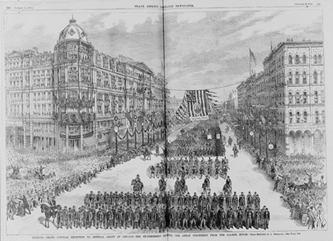3. The War of the Rebellion.
57th Illinois Regiment.
Martin was 19 years old and stood 5'5" when he enlisted as a private in the 57th Illinois Regiment, Company E on 19 January 1862. He served for a period of three and a half years in the Union Army during the American Civil War (reenlisting in Nashville, Tennessee on 20 Jan 1864). The Harper's Ferry musket issued to him had been converted from a flint-lock. While at Camp McIntosh near Sulphur Springs, his company was assigned picket duty. Supplies were short and the men had been served a meal of rotten sow belly and maggot-filled hard tack. They refused to take their posts until they received better food. The company was marched in front of General Oglesby who reminded them of their duty and who promised to shoot the lot of them if they did not report. The general did, however, see to it that the men had better provisions in the future.

His regiment participated in the Battles of Shiloh, Resaca and Kennesaw Mountain. They were with Sherman during the Siege of Atlanta and the March to the Sea, as well as the Battle of Bentonville. He marched from Illinois to Missouri, through Tennessee to Georgia, to South Carolina. More than 752,000 Americans died in the war - Martin mustered out 7 July 1865 in Louisville, Kentucky, about 2 months after Confederate General Robert E. Lee surrendered, and returned to live with his family in Chicago.
Martin married Lena Schwab.
In the 1865 Illinois census John and Gertrude Schnee declared the value of their livestock to be $400. The 1867 city directory indicates they resided at 157 Cornell in the north part of the city. The men were employed as varnishers and painters for the John Phillips Company. That same year, on May 9th, the 24 year old Martin married 19 year old Mary Madelina "Lena" Schwab. (There is some evidence he served in the same regiment as her brother Henry). The couple continued to live with his family. Martin's father was employed in the Wards chair factory according to the 1870 census and Martin and brother John were painters. The family home was valued at $2500. His brother Werner enlisted in the Army's 21st Infantry in 1870 and was sent out West where he would fight in the Indian Wars. Werner ultimately settled in Gibbonsville, Idaho where he went by the name William Snow, mined gold, married and subsequently divorced Amanda Wood. Back in Chicago, Martin and Lena's daughter Marguerite was born in August 1871.
But Ward's business went up in smoke in the Great Chicago Fire. Fueled by dry wooden buildings and accelerated by hot Southern winds the fire blew through the city October 8-10, 1871 as the Schnee's watched anxiously from their home across the river. Mayor Roswell Mason placed the city under martial law while panicked citizens fled to safety. In the end about 2,000 acres burned leaving a third of the population homeless.
The 1872 city directory reveals the Schnee's went to work at Thayer & Tobey Furniture. The company, which at that time specialized in French historical styles, supplied furniture to many of Chicago's grandest hotels including the Grand Pacific, Tremont and Palmer House. Martin and his brother were wood finishers.
Gertrude Schnee died 16 October 1872. She was laid to rest in an unmarked grave next to where her daughter Anna Puetz would later be interred in St. Boniface Cemetery in Chicago.
Martin and Lena had another daughter, Anna, who was born 6 February 1873. Martin's sister Anna married the shoemaker Theodore Puetz in 1875 and they would have seven children.
Grand Army of the Republic (GAR).
Like many Civil War veterans, Martin sought the fraternity of the men with whom he had served. Membership in the Grand Army of the Republic was limited to those who were honorably discharged after service in the Union Army during the War of the Rebellion. Annual encampments soon fostered a call to action to build soldier's homes and to provide benefits for veterans. The GAR was a strong supporter of the Republican Party and became very influential in presidential elections, even to helping to elect five of its members to the Presidency of the United States. It was behind the establishment in 1868 of a national Decoration Day (later called Memorial Day) to honor fallen soldiers.
In 1879 Martin was part of a GAR committee which arranged a welcome for former President and Commanding General of the U. S. Army Ulysses S. Grant during his visit to Chicago. This was reported in the Chicago Daily Tribune on November 3rd:

The ex-president reviewing the great procession from
the Palmer House / from sketches by A. Berghaus."
From Frank Leslie's illustrated newspaper, November 22, 1879
GRANT RECEPTION.
IN CHICAGO.
The Reception Arrangements.
The survivors of the Fifty-seventh Illinois Regiment held an adjourned meeting at the Grand Pacific Hotel yesterday afternoon to take action with reference to the reception to Gen. Grant. Col. S. B. Baldwin presided. It was unanimously decided to turn out in the parade as a regiment. The Chairman announced that about 100 members had promised to take part...and [men were chosen to] endeavor to secure the old colors for use on the day of the parade. The ... Reception Committee was also appointed: ... [composed of] Martin Schnee [and eight others]...It was decided to unite upon the old badge, which consists of a broad white ribbon with the words, 'Fifty-seventh Illinois Volunteers' printed thereon. Messrs. [William] Cluett and Kenyon were appointed to a committee to secure badges.
- Germans to America, Filby, P. William, and Ira A. Glazier
- Chicago Daily Tribune
- Google Books: History of the 57th... by William Cluett, p126
- https://www.loc.gov/rr/main/gar/garintro.html
- www.civil-war.com
- Chicago City Directory
